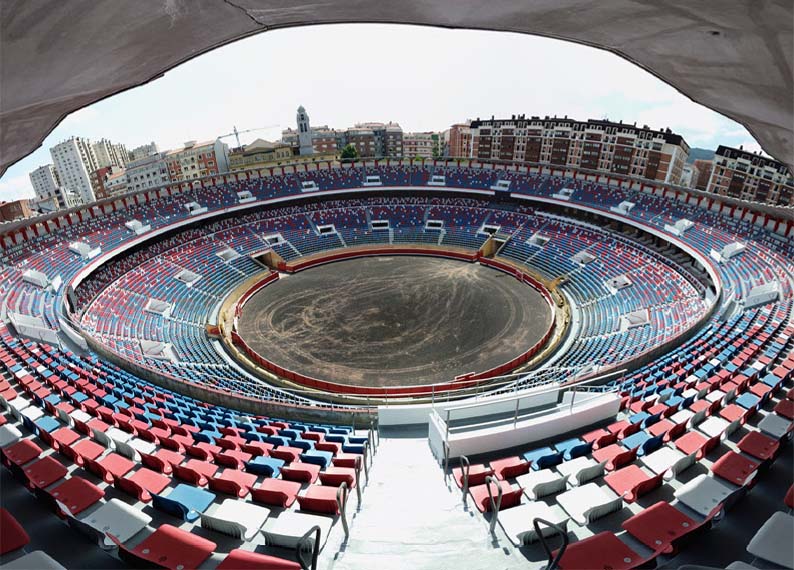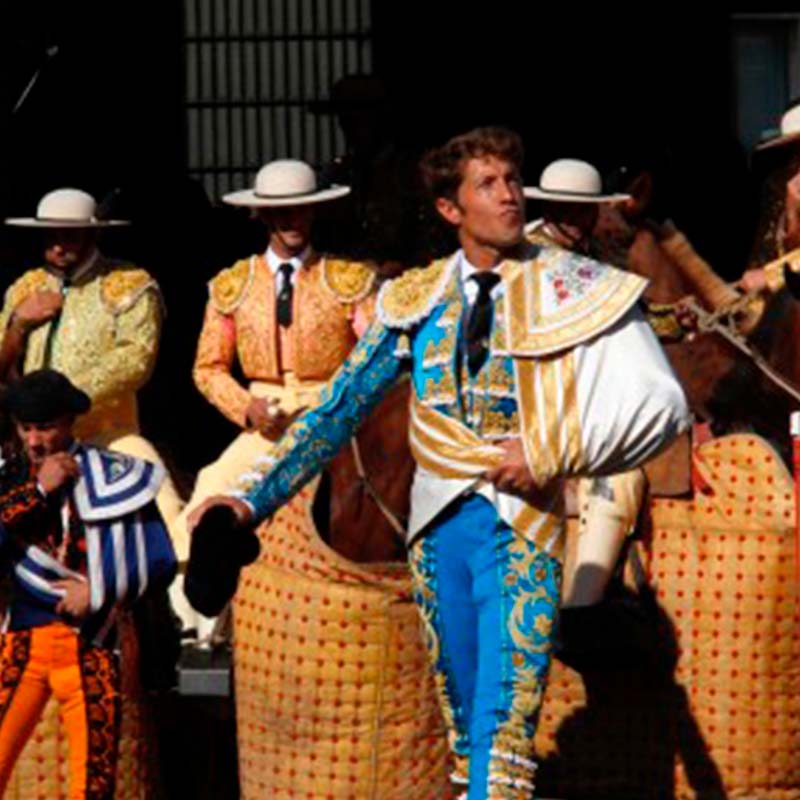Bilbao Bullring
The Bilbao bullring
The Vista Alegre Bullring is much more than a bullfighting venue for the people of Bizkaia; it is a symbol of the tradition, culture and history of Bilbao. Since its inauguration in 1882, it has witnessed unforgettable afternoons of glory, where the art of bullfighting has shone in all its splendour. For the city, Vista Alegre represents an inalienable heritage that has transcended generations, hosting not only bullfights, but also events that have marked the social and cultural life of Bilbao. Its presence is a constant reminder of the roots of bullfighting in the Basque Country and of the city’s capacity to renew and preserve its most cherished traditions.
"Bilbao is a bullring that honours and elevates the true essence of the bull. Fighting in Vista Alegre is both a privilege and a trial by fire for any bullfighter." — Victorino Martín (bull breeder)
The Fire at Vista Alegre Bullring: The Tragedy that Shaped Bilbao's Bullfighting History
The Vista Alegre Bullring, one of Bilbao’s most iconic bullfighting landmarks, was devastated by fire in the early hours of 5th September 1961, in one of the most tragic fires in the city’s history. This arena, witness to legendary performances and glorious afternoons with figures like “El Cordobés,” was engulfed in flames in just over an hour, leaving behind only the stone walls that withstood the fire’s ferocity.
The fire is believed to have started from a discarded cigarette butt that was left smouldering in the stands after the bullfight earlier that day. On that occasion, bullfighters José María Montilla, Rafael Chacarte, and “El Cordobés” had performed before a packed crowd. The cigarette, fanned by the dry wood of the arena and Bilbao’s night-time water cuts as part of conservation measures, became the catalyst for a fire that quickly spread.
Despite the efforts of caretaker José Echevarría, who had worked in the bullring for more than 25 years, and the firefighters who responded, the low water pressure in the hoses and the antiquated infrastructure made it impossible to control the blaze. The old wooden stands burned rapidly, and while the bulls and horses in the corrals were saved, the interior of the arena was completely destroyed.
This tragic event not only marked the loss of a symbol of Bilbao’s bullfighting culture but also closed a chapter in the city’s history. The bullring had been inaugurated in 1882, the result of architect Sabino de Goicoechea’s design and a public initiative promoted by the newspaper “La Unión Vasco-Navarra.” For nearly 80 years, Vista Alegre hosted memorable afternoons, including the first performance by the legendary tenor Julián Gayarre and the visit of famed novelist Ernest Hemingway, who immortalised the arena in his work Death in the Afternoon.
On 5th September 1961, as the flames lit up the Bilbao sky, it was not just a bullring that burned but also an essential part of the city’s cultural and bullfighting memory. The walls that remained standing served as a reminder of both the grandeur and the misfortune of an arena that had witnessed so much history.



"In Bilbao, the bull tests you, but it is the crowd that either crowns you or banishes you." — Juan Belmonte (bullfighter)



REBUILDING THE ARENA
In just nine months, the Vista Alegre Bullring rose from the ashes after the devastating fire that had destroyed it. Under the direction of Bilbao’s then-mayor, Lorenzo Hurtado de Saracho, the construction of a new arena was quickly set in motion to restore the city’s iconic bullring. The project, led by architect Luis María Gana y Hoyos, was carried out by contractors Olavarría, resulting in a modern bullring with a capacity for 14,785 spectators.
The new Vista Alegre Bullring was inaugurated on 19th June 1962 with a historic bullfight featuring three great figures of the bullfighting world: Antonio Ordóñez, César Girón, and Rafael Chacarte from Barakaldo. That evening, bulls from several renowned breeders were fought, including Juan Pedro Domecq, Carlos Urquijo, Atanasio Fernández, Antonio Pérez Tabernero, Marqués de Domecq, and Ricardo Arellano.
The first bull to step onto the new sand was “Limonero,” numbered 32, a striking animal weighing 493 kilos from the Juan Pedro Domecq ranch. Antonio Ordóñez, tasked with fighting it, cut the first ear of the newly rebuilt arena after a great performance with the fourth bull. César Girón also claimed a trophy, earning an ear from the fifth bull, while Rafael Chacarte, in a brilliant performance, cut both ears of the sixth bull, making it a memorable day.
The new Vista Alegre Bullring not only regained its status as the bullfighting epicentre of Bilbao but also set a new standard with its modern facilities, adapted to the demands of the time. The management of the bullring remained under the Junta Administrativa de Vista Alegre, which has since worked alongside the Casa Chopera. Today, the arena is managed by the BMF company, headed by the Bailleres family, who have continued to maintain its status as a leading venue in the bullfighting world.
"Bilbao's bullring is the most demanding stage in Spain. Here, the bull must be genuine, and the bullfighter, a true master." — Antonio Ordóñez (bullfighter)

Some curiosities about the Bilbao Bullring
The Bilbao Bullring, Vista Alegre, is surrounded by stories and curiosities that make it unique in the world of bullfighting. Inaugurated in 1882, its arena has witnessed extraordinary events, such as the unusual experiment of a simultaneous double bullfight in 1901, where two groups of bullfighters performed in separate rings until a bull leapt over the barrier, causing chaos. The legendary Ernest Hemingway also visited, captivated by the passion of Bilbao’s crowd. Additionally, the ring saw performances by female bullfighters like “La Temeraria,” at a time when few women dared to enter the arena. The demanding Bilbao fans and the seriousness with which bullfighting is lived in this plaza turn each performance into a true test for bullfighters. Its endurance through the devastating fire of 1961 only strengthens the indomitable character of this iconic arena.
INTERESTING FACTS The Bilbao Bullring in numbers
First Category
In this bullring the ‘Corridas de Rejones’ and the ‘Corridas concurso de ganaderías’ were invented.
Capacity
Subscribers
Bullfights per year
Bullfights per year
When are the General Bullfights held in Bilbao?
The Corridas Generales of Bilbao, held annually at the iconic Vista Alegre Bullring from 18th to 25th August, are the most eagerly awaited event of the bullfighting season in the city. This spectacle brings together the world’s top bullfighters, making it a true festival of tauromachia.
The significance of these bullfights lies not only in their prestige but also in their rich historical tradition. Bilbao, with its deep cultural connection to the world of bullfighting, has maintained this event as a symbol of its identity. Each year, the Corridas Generales attract fans from all over the world, establishing the city as a true epicentre of bullfighting.
Don’t miss the chance to be part of this unique celebration that honours the tradition and art of bullfighting!

‘The fans of Bilbao do not forgive bullfighting or bullfighters; they are one of the most knowledgeable and demanding’. - José Tomás (bullfighter)
Buy bullfighting tickets for Bilbao
Don’t miss the excitement of Bilbao’s Semana Grande!
Secure your spot at the Vista Alegre Bullring by purchasing your tickets for the bullfights in Bilbao in advance through Servitoro. Avoid the risk of tickets selling out at the last minute.
As the official authorised sales channel for the Plaza de Toros, we offer you the convenience of buying your tickets online, without the need to travel or queue. The process is quick and easy: book your tickets and receive them at the address you provide, between 2 and 4 days before the event.
Don’t miss the chance to experience this magnificent taurine celebration!
How to get to Bilbao’s bullring?
The bullring in Bilbao is located at Plaza de Toros, 1, 48003 Bilbao. If you’re in the city centre, it’s about a 20-minute walk. Enjoy the stroll through the city’s streets and take the opportunity to explore the surroundings.
Other options include:
Public Transport:
Metro:
Take Line 1 (Euskotren Line) or Line 2 (Basauri Line) to Bilbao Abando station.
From there, it’s about a 15-minute walk to the bullring.
Bus:
Several bus routes connect Bilbao city centre with the bullring. The nearest lines are:
- Line 13: towards Errekalde.
- Line 56: towards Zorroza.
Check the closest stops and confirm the timetable.
Tram:
Take the tram to the Plaza de Toros stop. From there, the bullring is just a few minutes’ walk away.
By Car:
If you prefer to drive, the bullring is well signposted. You can use navigation apps for precise directions.
Please note that parking may be limited on event days, so it’s advisable to arrive early.

Frequently Asked Questions
Yes, all children over 4 years old pay the adult ticket price.
Access with food depends on the organiser of the show. Before entering the bullring with food, you must check with the ticket office at the bullring.
The organisers reserve all image and intellectual property rights of the show. It is forbidden to film or take photos (with or without flash) during the bullfight.
The venue opens 2 hours before the show to avoid crowds so you can find your seat in peace and quiet.
Spectators will not be allowed to enter or leave their seats during the bullfight.
The tickets are in PDF format, you have to print the tickets directly at home. The PDF file will be sent to the email address you used to make the purchase.
The Organisers reserve the right to refuse entry to the venue to any User who does not provide their ticket in physical format (paper ticket).







